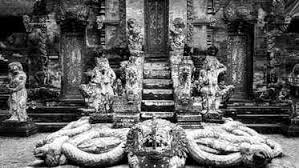
7 SNAKE DEITIES REVERED IN INDIA
In Hindu mythology, serpents or "Nagas" are much more than mere creatures; they embody potent symbols of power, protection, and fertility. Two of the three primary creators of the universe—Lord Shiva and Lord Vishnu—are intimately associated with these sacred serpents. Lord Shiva adorns his neck with the divine serpent Vasuki, while Lord Vishnu rests upon the mighty Sheshnaag. In India, snakes are revered as divine beings, and killing a snake is considered a grave sin, often believed to bring misfortune.
As Nag Panchami approaches—a festival celebrating these revered serpents—let us explore seven snake deities worshipped in India, each holding a unique place in Hindu mythology.
To buy a variety of hindu t shirts like shivji t shirt, hanuman t shirt, ganesh t shirt, Krishna t shirt, ram t shirt, bajrang bali t shirt etc. click here!
1. Anant Shesha
Mythological Background:
Anant Shesha, often referred to simply as Shesha or Adishesha, is a majestic and eternal serpent, considered the king of all Nagas (serpent deities). His name "Shesha" means "that which remains," symbolizing the eternal residue that stays after everything else has ceased to exist. In Hindu cosmology, Shesha is depicted as a massive serpent with multiple hoods, each hood carrying a planet or a heavenly body. According to the Puranas, he supports the entire universe on his hoods, and his uncoiling marks the beginning of time and creation.
Symbolism:
Shesha's role as the bearer of the universe represents stability, eternity, and the cyclical nature of time—creation, preservation, and dissolution. The coiled position signifies a state of rest, while the uncoiled position indicates the activation of time and cosmic activities. Lord Vishnu, the preserver of the universe, is often depicted resting on Shesha in the cosmic ocean, emphasizing Shesha's role in maintaining the balance of the universe.
Cultural Significance:
Shesha's association with Lord Vishnu places him at the heart of Vaishnavism, one of the principal traditions within Hinduism. Devotees of Vishnu honor Shesha as a protector and a symbol of the infinite. During Nag Panchami, prayers and offerings are made to Shesha for protection, stability, and continuity in life.

2. Vasuki: The Serpent of Sacrifice
Mythological Background:
Vasuki is another prominent serpent deity in Hindu mythology, best known for his role in the Samudra Manthan (churning of the ocean) event. During this cosmic event, the gods (Devas) and demons (Asuras) collaborated to churn the ocean to obtain Amrita, the nectar of immortality. Vasuki volunteered to serve as the churning rope, coiled around Mount Mandara. As the churning continued, Vasuki endured immense pain, and a deadly poison called halahala emerged. To protect the universe from destruction, Lord Shiva consumed the poison, which turned his throat blue, and Vasuki's sacrifice further solidified his divine status.
Symbolism:
Vasuki symbolizes sacrifice, endurance, and loyalty. His willingness to undergo immense suffering for the greater good underscores the values of selflessness and devotion. As Lord Shiva's constant companion, Vasuki also represents the inseparable bond between the divine and the natural world.
Cultural Significance:
Vasuki is revered by devotees of Lord Shiva, who see him as a symbol of loyalty and protection. He is also associated with prosperity, as he was involved in the churning that brought forth the treasures of the ocean. During festivals like Nag Panchami, Vasuki is honored with prayers and rituals to seek his blessings for health, wealth, and protection.

3. Karkotaka: The Protector of Bhimtal
Mythological Background:
Karkotaka is a lesser-known yet significant serpent deity in Hindu mythology. He is believed to reside in the region of Bhimtal, Uttarakhand, where a temple is dedicated to him. According to local legends, Karkotaka took residence in Bhimtal to protect the area from evil forces and negative energies. His presence is considered a blessing for the town and its people.
Symbolism:
Karkotaka embodies the protective and benevolent aspects of serpent deities. As a guardian, he is believed to ward off evil spirits and bring prosperity to those who worship him. His association with the natural landscape of Bhimtal also emphasizes the connection between serpent deities and the environment.
Cultural Significance:
The temple dedicated to Karkotaka in Bhimtal is a site of pilgrimage, especially during Nag Panchami. Devotees visit the temple to seek Karkotaka's protection and blessings for health and prosperity. The local community regards him as a guardian deity, and his worship is integral to the cultural identity of the region.

4. Takshaka: The Naga King
Mythological Background:
Takshaka is one of the most illustrious serpent kings in Hindu mythology, known for his appearances in both the Mahabharata and the Bhagavata Purana. He belonged to the Ikshvaku dynasty, descended from Lord Rama, and his son, Brihadbala, was killed by Arjuna's son, Abhimanyu, in the Mahabharata war. Takshaka is also associated with the curse of Parikshit, the grandson of Arjuna, whom Takshaka is destined to kill. This event sets in motion a series of events that lead to the recitation of the Bhagavata Purana.
Symbolism:
Takshaka represents the complex duality of serpents in Hindu mythology—both as protectors and as agents of fate. His role in the death of Parikshit highlights the inevitability of destiny, while his association with the Ikshvaku dynasty ties him to the royal lineage and divine order.
Cultural Significance:
Takshaka is revered in several temples across India, with the Tarakeshwar temple in Mandsaur, Madhya Pradesh, being particularly notable. Devotees seek his blessings for protection and the resolution of karmic debts. His story is also a reminder of the interconnectedness of fate, karma, and divine will in Hindu philosophy.

5. Kaliya: The Vanquished Serpent of Yamuna
Mythological Background:
Kaliya is a notorious serpent in Hindu mythology, known for his venomous presence in the Yamuna River near Vrindavan. According to the Bhagavata Purana, Kaliya's venom polluted the river, making it lethal for any living being that came into contact with it. The people of Gokulam suffered greatly due to Kaliya's presence. Lord Krishna, as a young boy, confronted Kaliya, subduing him by dancing on his many hoods. Kaliya, realizing Krishna's divine nature, surrendered and was forgiven. Krishna then banished Kaliya to a distant island, sparing his life and purifying the Yamuna.
Symbolism:
Kaliya represents the destructive potential of unchecked power and the need for divine intervention to restore balance. His defeat at the hands of Krishna symbolizes the triumph of good over evil and the power of divine grace to transform even the most malevolent beings.
Cultural Significance:
The story of Kaliya is celebrated in the region of Vrindavan, where the Kaliya Mardan (Krishna's subjugation of Kaliya) is a popular theme in local rituals, dances, and festivals. The Yamuna River, purified by Krishna, is considered sacred, and devotees often pray for the removal of obstacles and protection from harm, invoking Krishna's name. Additionally, in Fiji, many believe that Kaliya was exiled to their land, and he is revered by the Indian diaspora there.

6. Manasa: The Serpent Goddess
Mythological Background:
Manasa Devi is the goddess of snakes, particularly revered in Bengal, Assam, and other parts of northern India. She is believed to be the daughter of Lord Shiva and the sister of Sheshnaag and Vasuki. Manasa's mythology is rich with stories of her trials and tribulations, as she struggled to gain recognition and worship among the people. Despite the challenges, she became a powerful goddess, associated with fertility, prosperity, and protection against snakebites.
Symbolism:
Manasa represents the dual aspects of snakes—both feared and revered. As a goddess, she embodies protection, particularly against the dangers of snakebites, which were a common threat in ancient times. Her association with fertility also ties her to the earth and agricultural prosperity.
Cultural Significance:
Manasa is worshipped with great fervor during Nag Panchami, where she is invoked for protection against snakes and for general well-being. In Bengal, her worship is deeply intertwined with local customs and rituals, where devotees offer milk, flowers, and prayers to her idols. She is also associated with the monsoon season, as snakes are more visible during this time, and her blessings are sought to ensure a bountiful harvest.

7. Gulika: The Guardian of Healing
Mythological Background:
Gulika is one of the seven divine serpents who adorn Garuda, the celestial vehicle of Lord Vishnu. Unlike the other serpent deities, Gulika is specifically associated with healing and the protection of medicinal herbs and plants. In Hindu mythology, he is considered the guardian of the knowledge of antidotes and remedies, playing a crucial role in the preservation of life.
Symbolism:
Gulika represents the healing aspect of serpents, which, despite their venomous nature, are also seen as symbols of medicine and rejuvenation. His role as the protector of medicinal plants highlights the importance of balance in nature and the need to preserve knowledge for the well-being of humanity.
Cultural Significance:
Gulika is revered in Ayurveda, the traditional Indian system of medicine, where snakes are often associated with the healing properties of plants and herbs. Devotees who seek healing and knowledge in medicine may offer prayers to Gulika, especially during Nag Panchami. His worship is also tied to the idea of divine intervention in the curing of diseases and the protection of health.
Conclusion
The veneration of snake deities in India is deeply rooted in the country’s spiritual and cultural traditions. These seven snake gods and goddesses represent different aspects of life, from creation and destruction to protection, healing, and the preservation of cosmic order. Through their worship, devotees seek blessings for various aspects of their lives, acknowledging the powerful and often ambivalent nature of serpents. The reverence for these deities reflects the broader Hindu understanding of the interconnectedness of all life forms and the divine presence within nature.
[The images used in this blog post are not owned by Anime Devta, they are just for entertainment purposes]
| NAG PANCHAMI | LORD SHIVA | HINDU T SHIRT | SHIVJI T SHIRT | HANUMAN T SHIRT | GANESH T SHIRT | KRISHNA T SHIRT | RAM T SHIRT | BAJRANG BALI T SHIRT | HINDU | LORD VISHNU |
~Mimansa Sharma

